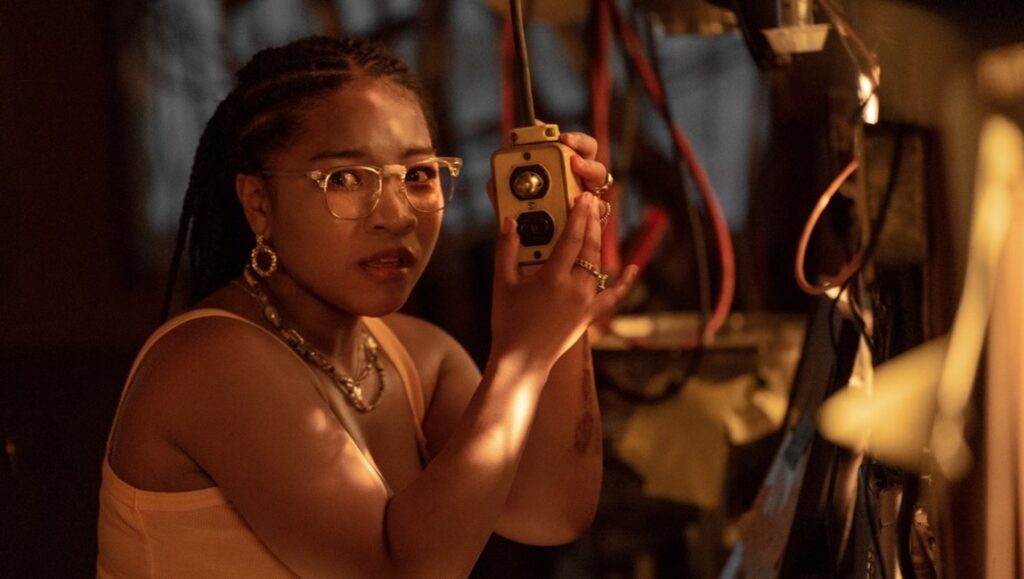There’s the kernel of a fascinating Frankenstein adaptation at the center of Bomani J. Story’s directorial debut, The Angry Black Girl and Her Monster. Taking Mary Shelley’s Lit 101 mainstay as inspiration, Story reconfigures that novel’s gothic horror to reflect a present-day America where racial injustice is woven into the nation’s very fabric. Victor is here swapped out for Vicaria (Laya DeLeon Hayes), a gifted Black high school student whose precociousness is beginning to bleed over into mad scientist territory. After losing both her mother and brother to violence, Vicaria’s trauma runs deep, but she buries it, shallowly, within her pursuits to “cure death,” which she describes as a disease. This germ of an idea, that death is catching, particularly within Black communities blighted by systemic oppression and state-sanctioned violence, offers the potential to yield incisive social critique and creative literary translation, but Story regrettably does little more than nod toward such substance. His efforts instead ultimately lie more in trading in tired horror tropes, only cursorily addressing the promising discursive throughline the film’s opening suggests.
That’s not to say there aren’t moments that land with force. Vicaria’s father, Donald (Chad L. Coleman), is a loving man caught in the grip of addiction following the dual losses of wife and son, and Story handles this thread with restraint, refusing to melodramatize his struggles and instead emphasizing the care and guidance he brings to his daughter’s life. Kango (Denzel Whitaker), a local drug dealer who brings Vicaria under this thumb, characterizes his supply of substance to Donald as the act of saving a family, and notes, “If there were more mental clinics around here than police precincts… hell, I’d probably be in a different job,” indicting a country that, at its core, only cares for the maintenance of old-guard glutted excess, the order of which is enforced through prejudicial public administration and militarized “law enforcement.” Unfortunately, Story seems to give the same weight to these limited opportunities for thorny sociological survey as he does the film’s more facile observations, skating quickly past promising rhetorical territory in pursuit of flaccid genre shenanigans.
The Angry Black Girl and Her Monster is most successful in its early going, finding genuine horror in embarrassing American realities. When Vicaria asserts herself during a science class and refuses to offer the contrition her teacher so desires, cops are called, and Vicaria is forcibly, violently arrested. An opening voiceover also mournfully details the cycles of violence and loss Vicaria has seen her family and community endure. But such instances are rendered largely, regrettably, textural once the film digs into its adaptation proper, which proceeds to establish Story’s soft flirtation with camp. You see, Vicaria has been lately body-snatching in order to re-alive her brother, and we are ushered into a sequence wherein she maniacally cackles while sewing together various viscera and rotten flesh. The subsequent resurrection “science” resembles a Rube Goldberg machine more than anything and relies on siphoning electricity from a local power station; yes, in 2023, when we have discovered that strides in Epigenetics may offer the closest “cure” to death we’ve yet found, we’re still relying on giant makeshift defibrillators as the horror go-to for reanimation. Regardless, the Frankenstein moment succeeds, and Vicaria’s brother Chris returns, except gnarly and indiscriminately homicidal.
Therein lies the problem. In order for The Angry Black Girl and Her Monster to succeed as sturdy adaptation, its metaphor(s) must be tight. That’s not to suggest Story’s film should forego its fusion of social realism and schlock in favor of art horror hooey, but only that its conceit should maintain some basic continuity of vision. For instance, based on the ideas the film espouses, Chris’ return should serve some kind of anti-establishment narrative function, a rage against the racist machine that has brought such pain, but the motivation and direction of his violence seem murky at best, and entirely logic-less at worst. His rampage is contained to his locality, waged against his family and Kango — basically, the film’s only characters — and if there’s any intentional commentary to be found in that, it’s far too muddled up with visual motifs of lumbering horror baddies to calcify. It won’t be hard for viewers to make the necessary analytical leaps to find avenues to substantive discourse, but the film’s digressions and lack of consistent focus make it nearly impossible to argue that the final product is a fully-cooked vision.
Unlike the way that Frankenstein’s full title forecasts its thematic terrain — The Modern Prometheus invoking that antiquitous tale of rejecting oppressive systems, and the ill that comes from defying the powers that be — The Angry Girl and Her Monster’s suggests an analogous, modern-day study that is only tilted at. Add to that conceptual limitation the film’s frustrating aesthetic character — lo-fi practical effects and B-movie-level “monster” design feel constantly at odds with the film’s sleek digital sheen — and viewers are left with little to actually chew on, outside of some strong performance than offer of modicum of grace. A whole lot is dangled in Story’s film about the casual violence inflicted on Black bodies that America condones and legalizes, but most of that laudable provocation is frustratingly lost in the chaos of a failed experiment.
Published as part of InRO Weekly — Volume 1, Issue 23.
Enjoy our content? Want early access to features, interviews, and more? Support us on Patreon!


Comments are closed.